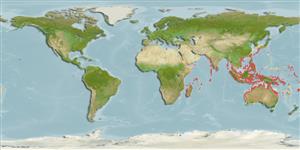>
Kurtiformes (Nurseryfishes, cardinalfishes.) >
Apogonidae (Cardinalfishes) > Apogoninae
Etymology: Fibramia: Latin 'fibra' meaning thread or filament and the feminine Greek 'amia' often applied as an ending for some cardinalfish genera as well as an incorrect past usage as a cardinalfish genus. The name refers to two characteristics of the species in this genus, an elongate second dorsal spine in one species and the narrow, pale or dark mid-line on the body of two species.
More on author: Cuvier.
Environment: milieu / climate zone / depth range / distribution range
Ekologi
laut berasosiasi dengan karang; nir-ruaya; kisaran kedalaman 0 - 20 m (Ref. 48635), usually 0 - 12 m (Ref. 90102). Tropical
Indo-Pacific: south to Natal, South Africa (Ref. 4329) and east to western Pacific.
Size / Weight / umur
Maturity: Lm ? range ? - ? cm
Max length : 8.5 cm TL jantan/; (Ref. 90102)
deskripsi pendek
Kunci identifiaksi (pengenalan) | Morfologi | Morfometrik
Duri punggung (Keseluruhan (total)) : 7; duri punggung lunak (Keseluruhan (total)) : 9; Duri dubur: 2; Sirip dubur lunak: 8. Black stripe from snout through eye to angle of opercle; tip of 1st dorsal present; caudal spot present (Ref. 4329, 48635). Sometimes has yellow barring on sides (Ref. 48635). 2-3 tiny black spots along base of dorsal fin; greatest depth of body 2.6-3.0 in SL (Ref. 90102).
Found in deep coastal reefs (Ref. 8631). Form small schools with outcrops on reef on sand to depths of 20 m (Ref. 48635); or among rocks or corals of shallow sheltered lagoons (Ref. 7300); often in seagrass beds (Ref. 37816). A nocturnal species (Ref. 7300).
Mouthbrooders (Ref. 240). Distinct pairing during courtship and spawning (Ref. 205).
Kailola, P.J., 1991. The fishes of Papua New Guinea: a revised and annotated checklist. Vol. III. Gobiidae to Molidae. Research Bulletin No. 41, Research Section, Dept. of Fisheries and Marine Resources, Papua New Guinea. 153 p. (Ref. 6771)
Status IUCN Red List (Ref. 130435: Version 2024-1)
ancaman kepada manusia
Harmless
penggunaan manusia
Perikanan: nilai komersial kecil; Akuarium: Komersial
Alat, peralatan
laporan khas
muat turun XML
Sumber internet
Estimates based on models
Preferred temperature (Ref.
123201): 24.9 - 29.3, mean 28.5 °C (based on 2879 cells).
Phylogenetic diversity index (Ref.
82804): PD
50 = 0.6250 [Uniqueness, from 0.5 = low to 2.0 = high].
Bayesian length-weight: a=0.00550 (0.00223 - 0.01355), b=3.27 (3.06 - 3.48), in cm total length, based on LWR estimates for this (Sub)family-body shape (Ref.
93245).
Trophic level (Ref.
69278): 3.5 ±0.50 se; based on food items.
Daya lenting (Ref.
120179): Tinggi, Waktu penggandaan populasi minimum kurang dari 15 bulan (Preliminary K or Fecundity.).
Fishing Vulnerability (Ref.
59153): Low vulnerability (10 of 100).
Nutrients (Ref.
124155): Calcium = 202 [104, 376] mg/100g; Iron = 1.09 [0.59, 1.88] mg/100g; Protein = 18.5 [17.4, 19.7] %; Omega3 = 0.103 [0.055, 0.201] g/100g; Selenium = 32.3 [14.1, 73.2] μg/100g; VitaminA = 81.2 [24.5, 255.6] μg/100g; Zinc = 2.32 [1.45, 3.50] mg/100g (wet weight);
